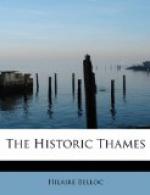Staines cannot take its place with these, for in spite of its high strategical value, of its old Roman tradition, of its proximity to London and the rest, Staines was throughout the Middle Ages, and till long after, rather a village than a town. Though a wealthy place it is purely agricultural in the Domesday Survey, and the comparative insignificance of the spot is perhaps explained by the absence of a bridge. That absence is by no means certain. Staines after all was on the great military highway leading from London westward, and it must have been necessary for considerable forces to cross the river here throughout the Dark Ages and the early Middle Ages, as did for instance, at the very close of that period, the barons on their way to Runnymede; and far earlier the army that marched hurriedly from London to intercept the Danes in 1009, when the pagans were coming up the river, and whether by the help of the tide or what not, managed to get ahead of the intercepting force. But if a bridge existed so early as the Conquest, we have no mention of it. The first allusion to a bridge is in the granting of three oaks from Windsor for the repairing of it in 1262. It may have existed long before that date, but it is significant that in the Escheats of Edward III., and as late as the twenty-fourth year of his reign—that is, after the middle of the fourteenth century—it is mentioned that the bridge existed since the reign of Henry III., which would convey the impression that in 1262 the bridge had first needed repairing, being built, perhaps, in the earlier years of the reign and completed, possibly, but a little after the death of King John.
This bridge of Staines was most unfortunate. It broke down again and again. Even an experiment in stone at the end of the last century was a failure, because the foundations did not go deep enough into the bed of the river. An iron absurdity succeeded the stone, and luckily broke down also, until at last, in the thirties of the nineteenth century, the whole thing was rebuilt, 200 yards above the old traditional site.
Staines is of interest in another way, because it marks one of those boundaries between the maritime and the wholly inland part of a river which is in so many of the English valleys associated with some important crossing. The jurisdiction of the port of London over the river extended as high as the little island just opposite the mouth of the Colne. On this island can still be seen the square stone shaft which is at least as old as the thirteenth century (though it stands on more modern steps), and which marks this limit, as it does also the shire mark between Middlesex and Buckingham.




